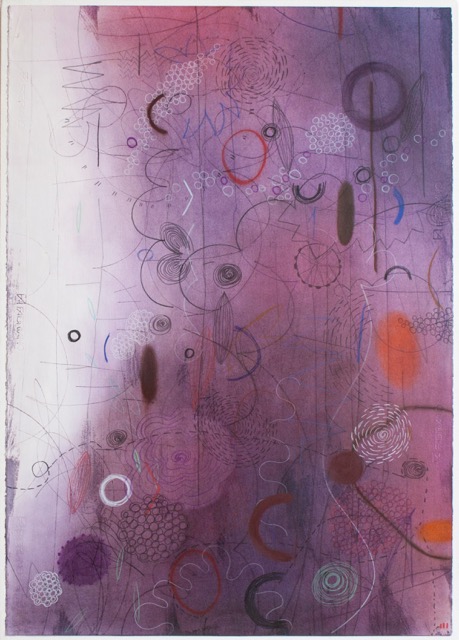
02 Jun Telluride Gallery: Whitehorse, Berlant, Garvin in June!
Thursday, June 4, 2020 marked the first Telluride Arts’ Art Walk of the summer season. For the month of June, the Telluride Gallery of Fine Art is featuring the work of Emmi Whitehorse, Tony Berlant and Elizabeth Garvin. And please note: Until July 5, the Gallery is donating a percentage of its proceeds to the copeprogram.org.

Emmi Whitehorse, Rain Lining.
Emmi Whitehorse:
Paul Klee, (1879-1940), is variously known as a Bauhaus master and forefather of Surrealism. However you look at it, the artist was a tough dude to pin down.
However, one thing for sure: the seemingly cockamamie system of pulsing and bobbing otherworldly creatures that populate Klee’s compositions evolved out of a deeply mystical place and definitely marked some of the very first efforts in the 20th century to embed spiritual content and the subconscious into abstract art. (And Klee was in good company, Kandinksy and Picasso among his peers.)
Wave bye-bye to the faithful representation of people, places and things in the “real” world.
Klee was a lodestar for influential Surrealists such as Miro and and later, for American greats such as Mark Rothko, Robert Motherwell, Kenneth Noland, Theodoros Stamos, Mark Tobey, William Baziotes, Gene Davis, Jackson Pollock, and Adolf Gottlieb. The subtext of the collective body of their work was representing the mystical through art.
Emmi Whitehorse shoehorns easily into that group.
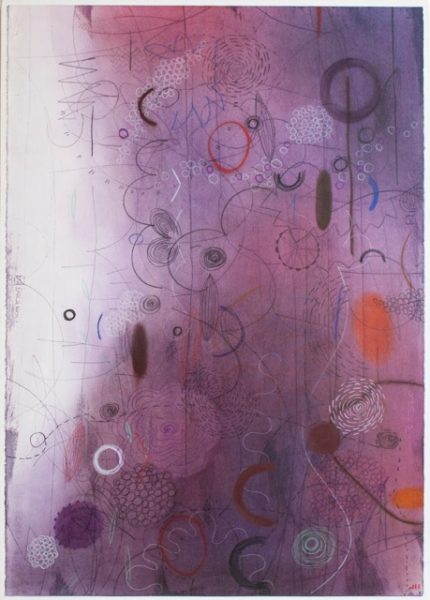
Whitehorse is a painter and printmaker who uses a private language of symbols and memories to make ‘“personal diaries” of her life as an artist of aboriginal heritage. Her textures, colors and compositions conjure the vibe of the stark New Mexico landscape, taking us all on a magical, mystery tour of her ‘hood.
“This land appears in her work simultaneously as very distant and very close up, in atmospheric washes and sharp details and lines. As we see, her paintings are consummate abstractions, welcome in the world of art for art’s sake for their neatly balanced forms and colors. They are also metaphysical views from the Navajo world. As such, they offer to viewers ‘from both worlds’ a glimpse of what art can be,” wrote critic Lucy Lippard
“As an artist I have intentionally avoided politically oriented subject matter and angst-ridden or physical wrestling with the act of painting itself. To make art, the act of making art must stay true to a harmonious balance of beauty, nature, humanity and the whole universe. This is in accordance with Navajo philosophy. I have chosen to focus on nature, on landscape. My paintings tell the story of knowing land over time – of being completely, microcosmically within a place. I am defining a particular space, describing a particular place. They are purposefully meditative and mean to be seen slowly. The intricate language of symbols refer to specific plants, people and experiences. …My work is about and has always been about land, about being aware of our surroundings and appreciating the beauty of nature. I am concerned that we are no longer aware of those. The calm and beauty that is in my work I hope serves as a reminder of what is underfoot, of the exchange we make with nature. Light, space and color are the axis around which my work evolve,” wrote Whitehorse.
Light, space, color – and a vivid imagination that grows big and wild in the artist’s fertile interior landscape.
Selected Collections
American Embassies- Japan, Uzbekistan, Slovenia
Denver Art Museum
National Museum of the American Indian,
DC Wheelwright Museum, Santa Fe, NM
Whitney Museum of American Art, New York
Crystal Bridges, Bentonville, Arkansas
Brooklyn Museum, Brooklyn, NY
Arizona State University Art Museum, Tempe, AZ
Minneapolis Institute of Art, Minneapolis, MN
Tony Berlant:
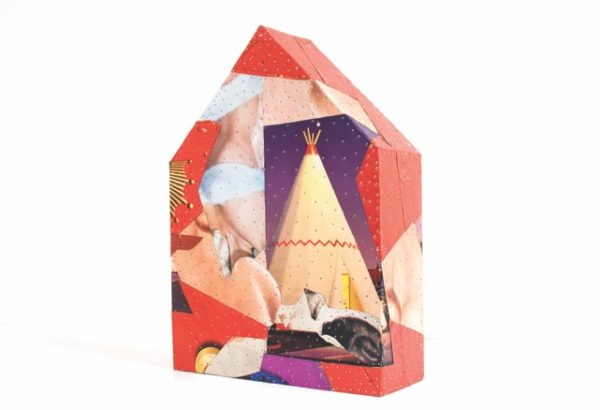
Unlike conventional mixed-media pieces created from cutouts of random images from magazines or photographs and taped or glued to a surface, art world titan Tony Berlant works with photo-printed metal (using the artist’s own images, plus vintage and modern metal signage and graphics) and found tin, which he fastens to panels with shiny steel nails, surrogates for his thumb print. The end result is a hybrid that lies at the intersection of painting, sculpture and photography, also Pop art (for its appropriation and elevation of everyday objects), assemblage and abstraction. The work is, at once, all of, yet none of the above: Berlant is his own “ism.”
Berlant once said: “The brain finds patterns and metaphors pleasing. This is regarding image-making strategies that encourage the viewer’s participation in meaning.”
Which Berlant’s armored quilts or sculptural paintings certainly do: some of the splintered images are quickly and easily recognizable; others not so much.
Back in the day, a young Berlant lived between his SoHo studio in New York and L.A., where the locus of that avant-garde art scene was a former storefront on La Cienaga Boulevard known as the Ferus Gallery, a very special venue which nurtured the city’s first truly significant postwar artists from 1957-1966. The vanguard of the scene that emerged from that clean white cube of a space included luminaries like Ed Moses, Ed Kienholz, Robert Irwin, Craig Kauffman, Billy Al Bengston, Ken Price, Joe Goode, John Altoon, Larry Bell, Ed Ruscha – and Berlant.
But if you bracketed Berlant with those Left Coast art world titans alone you would be leaving out a large chunk of his ever-evolving story.
Adding Pop icon Any Warhol’s name to the list, an acquaintance and inspiration, inches you closer to the truth, but assemblage sculptors and collage workers Robert Rauschenberg, Kurt Schwitters and Joseph Cornell also make cameo appearances in Berlant’s narrative.
Rauschenberg, another fecund talent, taught Americans (back in the 1960s and 1970s when he loomed larger-than-life) that all of life could be open to art – from tin cans to stones to a stuffed goat, taken individually or collaged together as unlikely bedfellows.
Dadaist Schwitters actually put out a similar message first, fashioning his collages from garbage he collected on the streets and transforming society’s throw-aways into harmonious arrangements which incorporated printed material.
Using the Surrealist technique of unexpected juxtaposition, Cornell’s eccentric creations also anticipated Rauschenberg’s (and by extension Berlant’s), revolutionary thinking. His best-known creations are glass-fronted boxes into which he placed and arranged Victorian bric-a-brac, old photographs, dime-store trinkets, and other found elements. Generally referred to as “shadow boxes,” the resulting work are dream-like miniature tableaux that inspire the viewer to see each component in a new light.
Again the challenge to viewers to allow their minds to free-associate and see. familiar things differently.

Tony Berlant, For Print Home Run
Taking nothing away from Berlant’s deep intelligence and inventiveness, qualities that comes through in his work, the artist might also have picked up a trick or two from Frank Stella and Sigmund Polke.
Stella’s dynamic, brightly colored, highly tactile later works literally extended painting into the third dimension. Those reliefs entered the viewer’s space via protruding materials the artist incorporated in the pieces.
A multi-media artist, Polke also innovated techniques in painting and photography. And like Warhol, he both mocked and elevated consumerism and the idea of brands using the imagery of pop culture and advertising. The resulting paintings (also his photographs, film installations and prints) are at once provocative and playful.
Berlant was first drawn to printed tin signage around 1963, when a shop near his studio in Los Angeles closed down and left behind a discarded sign. Upon investigation, Berlant found not one, but several abandoned tin signs wedged behind the first one. Like a time capsule or an archeological site, each sign indexed to a different time, reduced by weathering and age to various states of rust and legibility. Those signs soon made their way into Berlant’s studio where his curiosity led him to cut them apart and play with rearranging the bits and pieces in new ways. Over a decade ago, the artist started using photographs he took himself and had them digitally spray-painted on metal, a way of expanding his lexicon and making it all much more personal.
Which art is anyway: both personal and universal (if it is good).
Selected Collections
Art Institute of Chicago, IL
Hammer Museum, Los Angeles, CA
Hirshhorn Museum and Sculpture Garden, Washington D.C.
Los Angeles County Museum of Art, LA,
CA Minneapolis Institute of Fine Art, Minneapolis, MN
Museum of Contemporary Art, Los Angeles, CA
Palm Springs Desert Museum, Palm Springs, CA
Philadelphia Museum of Art, Philadelphia, PA
San Diego Museum of Contemporary Art, San Diego, CA
San Francisco Museum of Modern Art, San Francisco, CA
Stanford Museum of Art, Palo Alto, CA
The Oakland Museum, Oakland, CA
Whitney Museum of American Art, New York, NY
Elizabeth Garvin:
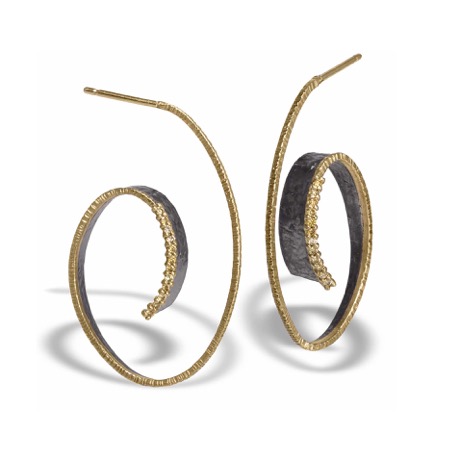
Elizabeth Garvin graduated with honors from New York University in 1986, earning a Bachelor of Arts degree, with further studies at Parsons School of Design and Massachusetts College of Art.
As examples of contemporary design in wearable art, Gavin’s jewelry is exhibited internationally in numerous galleries and museum stores, as well as in home-furnishings and design-focus boutiques.
Aa a metal artist and designer whose signature is hard geometry and industrial elements, Garvin’s goal remains to create forms with classic elegance and enduring quality, while integrating various techniques and, at times, parting with tradition as a part of her overall design concept.
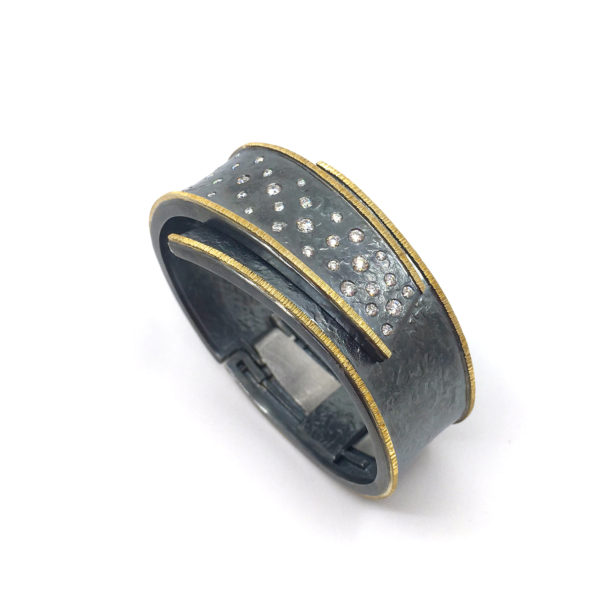
Each piece of Garvin jewelry is handmade in the artist’s New York studio. Applying various techniques of patterning and finishing, each object is playfully graphic, yet sensibly crafted.
Garvin’s approach to designing form, engineering movement and developing techniques draws as much from architecture and industrial design as it does from the traditional craft of jewelry-making.
“Jewelry is going to touch you, be part of what you feel throughout the day. It has to make sense on the body,” explains the artist.
Materials + Accolades
18k gold, palladium, sterling silver, precious stones, diamonds
Mort Abelson New Designer of the Year,
Jewelers of America 2012 Palladium Prestige Award,
AGtA Spectrum,
2013
Niche Awards, fine jewelry, 2012


Pingback:June Art Walk, Slate Gray | Telluride Inside... and Out
Posted at 17:42h, 02 June[…] Please check out a related Art Walk post highlighting the artists featured at the Telluride Gallery of Fine Art: Emmi Whitehorse, Tony Berlant and Elizabeth Garvin. […]